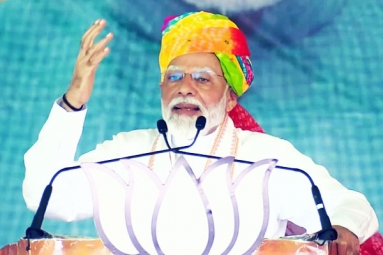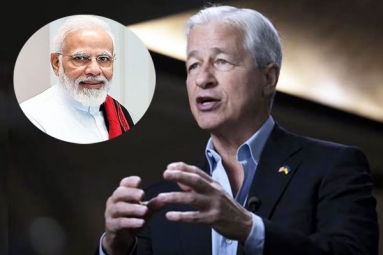
(Image source from: Why Modi government should stop creating a language divide?})
Narendra Modi and his government are precariously close to kindling an uncalled-for language barrier in a country where there is none. In their bid to make Hindi the new lingua franca of Indian diplomacy, the new government has been ruffling quite a many feathers.
A couple of weeks back, the new Prime Minister of India, asserted his "Indian-ness" by addressing foreign dignitaries from SAARC nations in Hindi during his swearing-in ceremony - an entirely justifiable personal decision. After all, leaders are allowed to speak in the language they feel home at.
However, the new government’s latest orders asking all ministries to communicate in Hindi across all social media platforms seems to be transgressing one's right and decision to speak in a language one understands best. India being the home to 780 languages currently including English, would it be fair to shove down the Hindi chauvinism down one's throat.
Just a day after Prime Minister Narendra Modi's swearing-in to the office on May 26th, 2014, the home ministry announced that Hindi be made as the compulsory mode of communication across the social media. The inter alia read: “It is ordered that government employees and officials of all ministries, departments, corporations or banks, who have made official accounts on Twitter, Facebook, Google, YouTube or blogs, should use Hindi, or both Hindi and English, but give priority to Hindi."
While this might have come as a shocker to many non-Hindi speaking leaders and junta, know that this isn't something new. In fact, this has been a part of government’s covert or overt official policy for a long time now.
If you have noticed, all government websites includes both Hindi and English versions. Even the Press Information Bureau of India (PTI) has Hindi version on top followed by the English edition so is the Reserve Bank of India (RBI) site.
To cut the long story short, the effort to enforce Hindi started way ahead before Modi's rise to power. So the home ministry's imposition is nothing new. It has been there since a long time, only that we didn't give it a second thought as English had always been there. The order to communicate in Hindi in social media is also in accordance with the standard policy on official websites of the government of India.
All said and done, what's especially giving the non-Hindi speaking leaders a knot on their gut is the phrase that stresses on “priority to Hindi”. Needless to say ministers like DMK leader M Karunanidhi are miffed.
Prior to Modi, even Congress government tried to enforce the same. But that didn't drew as much buzz and looked as threatening as when being done by Narendra Modi or Rajnath Singh. The perception that Modi is trying to make “Hindi important” is likely to get more tongues wagging than during Congress' times.
Modi addressing to foreign dignitaries is understood; he addressing Indians in Hindi is also justified. But giving Hindi more privilege that other official languages is not acceptable to many.
That brings us to the most important question: Is Modi the only one to be pushing Hindi at the cost of English or third languages. The answer is “No”. Like the centre, many other states are driving their regional languages at the cost of Hindi, English or any other third language. The truth is linguistic chauvinism exists everywhere — but it's only when leaders like Modi start championing it, it makes headlines.
Nevertheless, one thing that we all must understand is that India is a globalizing world where people from various states and abroad come to study, work and settle down in states other than their own, it's important that the country has a more people-friendly language policy to help people communicate well, and not exercise just Hindi or regional language chauvinism.
For example, consider Karnataka that prides itself on being the Silicon Valley of India and hosts IT officials from all across India and other parts of the world, or Maharashtra, the financial capital of the country, which sees people from all ethnicity and race. Now if these states only used Kannada or Marathi for public communication, then would it be possible for the states to make any progress?
If a country like Singapore can officially recognize four languages — English, Mandarin, Tamil and Malay, why can't Tamil Nadu have Tamil, English, Hindi, and Malayalam/Telugu as its official languages too?
Post the anti-Hindi agitations in the 1960s, India formulated a three-language strategy that emphasized learning English, Hindi and a regional language at the school level. However, many states only adopted the two-language formula while Hindi-speaking states only emphasized on single language strategy.
The Modi government would do well by not granting any special privilege to Hindi over other languages. Rather than making Hindi the language of social media alone, it should start tweeting in all other major Indian languages like Marathi, Tamil, Telugu and Bengali.
Let's not forget, language is meant for communication and self-expression. It should not exclude people from participating just because they are unfamiliar with a foreign tongue. For a country like India dreaming to make its rightful place in the global map, the more languages used for public communications, the merrier.
AW: Suchorita Choudhury










